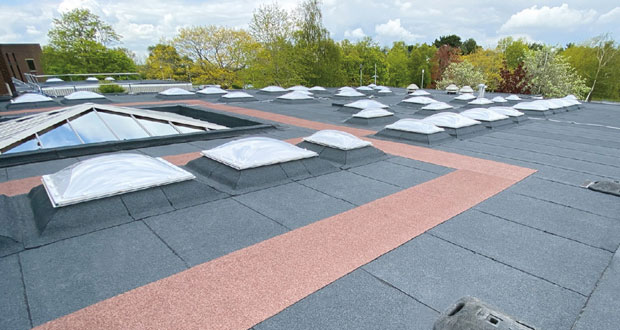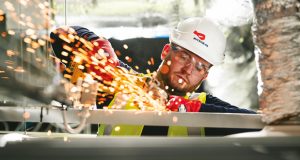ASSESSING ROOF CONDITIONS
A roof condition survey is essential to allow an accurate assessment of the roof condition and to determine whether any failures have already happened that need remedial work or if there are pre-emptive steps that can ensure a potential failure doesn’t progress.
A condition survey begins with a detailed visual inspection, looking for any indications of a problem that needs resolving. This may involve a drone survey if the roof is difficult to access. Suppose there is indeed a suspicion that a failure may have occurred. In that case, there are a variety of methods to investigate and diagnose if this has progressed to an actual failure of the waterproofing membrane and, if so, the extent of the damage.
INVESTIGATIVE WORKS
A diagnostic tool that can be used is a Tramex moisture meter. This digital device can detect the moisture content within a roofing membrane and the substructure and allows a map to be created detailing the position and extent of any moisture ingress.
Another helpful tool is a digital thermal imaging device. This allows for a thermographic survey inspection to be carried out, which again will show in detail if a leak has occurred, track where the problem originated and assess the extent of the damage caused.
Both diagnostic methods allow for an extremely accurate assessment that can quickly ascertain the roof’s overall condition and localise areas that need repairs.
Once the problem areas are identified, core sampling is conducted to establish the existing build-up of the roofing structure and provide information on the condition of the roof deck and any underlying issues.
This investigative work provides vital data that can be used to determine the cause and extent of any damage. This dictates the best course of action, ensuring that no superfluous refurbishment works are conducted, minimising costs and eliminating unnecessary waste.
WHEN TO REPAIR OR REPLACE: FACTORS TO CONSIDER
So, with the roof survey and related investigative works completed, there is an adequate amount of data to assess the extent of the damage to the existing roof. Where the damage is not extensive or is localised in a specific area, a repair will always be the best course of action. A full roof replacement is warranted at the other end of the scale, where the damage is extensive, especially if it has begun to compromise the roofing deck.
But what if the damage is somewhere in between? This is where additional factors come into play, namely the age of the roof and the comparative cost-effectiveness of a full replacement compared to the cost of extensive repairs. The closer the existing roof is to its expected end of life, the more likely a full replacement will be the best solution, as more failures are likely to occur in the near future, which changes the comparative cost-effectiveness of each solution. Replacing an old roof can also provide additional benefits, such as increased thermal insulation, which will help to reduce the operational costs of your building.
One final factor that may dictate the chosen solution is budgetary constraints. While not necessarily the most cost-effective solution, a short-term solution may be needed to resolve the immediate problem and allow time to gather the required capital for a full roof replacement.
ENVIRONMENTAL CONSIDERATIONS
Unnecessary refurbishment and roof replacement works cost more than just money; they also harm the environment, specifically the embodied carbon emissions of your building.
The longer the life cycle of your chosen roofing solution, the more significant the improvement in its embodied carbon emissions. Two of the circular economy principles, reduce and repair, dictate the most sustainable approach that should be taken. By repairing only what is actually necessary, we reduce the amount of waste that is generated that is destined for landfill. This will help the environment and enable you to achieve your business’ carbon commitments.





